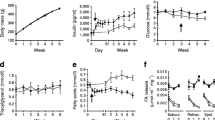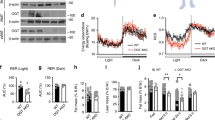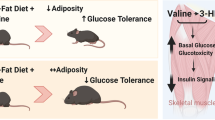Abstract
Excess fatty acids and carbohydrates have both been implicated in the pathogenesis of type 2 diabetes, and both can reproduce essential features of the disease including insulin resistance and beta cell failure. It has been proposed that both nutrients may regulate metabolism through a common fuel sensing mechanism, namely hexosamine synthesis. We have previously shown that transgenic overexpression of the rate-limiting enzyme for hexosamine synthesis, glutamine:fructose-6-phosphate amidotransferase (GFA), targeted to muscle and fat, leads to insulin resistance mediated by increased O-linked glycosylation of nuclear and cytosolic proteins. We report here that hexosamine-induced insulin resistance is not additive with that induced by high fat feeding. In control mice fed a high fat diet, glucose disposal rates during euglycemic hyperinsulinemia were decreased by 37% (p < 0.02) compared to mice on a low fat diet. Transgenic mice overexpressing GFA and fed a low fat diet exhibited a 51% decrease in glucose disposal compared to controls on a low fat diet (p < 0.001), but no further decrease was evident in the transgenic mice fed a high fat diet. Decreased glucose disposal rates were mirrored by increases in skeletal muscle levels of the principal end product of the hexosamine pathway, UDP-N-acetyl glucosamine. Serum leptin levels, which are modulated both by feeding and hexosamine flux, also show no additivity in their stimulation by GFA overexpression and high fat feeding. These data are consistent with a shared nutrient sensing pathway for high fat and carbohydrate fluxes and a common pathway by which glucose and lipids induce insulin resistance.


Similar content being viewed by others
References
Baron AD, Zhu JS, Zhu JH, Weldon H, Maianu L, Garvey WT (1995) Glucosamine induces insulin resistance in vivo by affecting GLUT4 translocation in skeletal muscle. Implications for glucose toxicity. J Clin Invest 96:2792–2801
Bergman RN, Ader M (2000) Free fatty acids and pathogenesis of type 2 diabetes mellitus. Trends Endocrinol Metab 11:351–356
Boden G (1997) Role of fatty acids in the pathogenesis of insulin resistance and NIDDM. Diabetes 46:3–10
Choi CS, Lee FN, Youn JH (2001) Free fatty acids induce peripheral insulin resistance without increasing muscle hexosamine pathway product levels in rats. Diabetes 50:418–424
Cooksey RC, Hebert LF Jr, Zhu JH, Wofford P, Garvey WT, McClain DA (1999) Mechanism of hexosamine-induced insulin resistance in transgenic mice overexpressing glutamine: fructose-6-phosphate amidotransferase: decreased glucose transporter GLUT4 translocation and reversal by treatment with thiazolidinedione. Endocrinology 140:1151–1157
Copeland RJ, Bullen JW, Hart GW (2008) Cross-talk between GlcNAcylation and phosphorylation: roles in insulin resistance and glucose toxicity. Am J Physiol Endocrinol Metab 295:E17–E28
Giaccari A, Morviducci L, Zorretta D, Sbraccia P, Leonetti F, Caiola S, Buongiorno A, Bonadonna RC, Tamburrano G (1995) In vivo effects of glucosamine on insulin secretion and insulin sensitivity in the rat: possible relevance to the maladaptive responses to chronic hyperglycaemia. Diabetologia 38:518–524
Hanover JA, Cohen CK, Willingham MC, Park MK (1987) O-linked N-acetylglucosamine is attached to proteins of the nuclear pore. Evidence for cytoplasmic and nucleoplasmic glycoproteins. J Biol Chem 262:9887–9894
Hawkins M, Barzilai N, Liu R, Hu M, Chen W, Rossetti L (1997) Role of the glucosamine pathway in fat-induced insulin resistance. J Clin Invest 99:2173–2182
Hazel M, Cooksey RC, Jones D, Parker G, Neidigh JL, Witherbee B, Gulve EA, McClain DA (2003) Activation of the hexosamine signaling pathway in adipose tissue results in decreased serum adiponectin and skeletal muscle insulin resistance. Endocrinology 145(5):2118–2128
Hebert LF Jr, Daniels MC, Zhou J, Crook ED, Turner RL, Simmons ST, Neidigh JL, Zhu JS, Baron AD, McClain DA (1996) Overexpression of glutamine:fructose-6-phosphate amidotransferase in transgenic mice leads to insulin resistance. J Clin Invest 98:930–936
Hoehn KL, Salmon AB, Hohnen-Behrens C, Turner N, Hoy AJ, Maghzal GJ, Stocker R, Van Remmen H, Kraegen EW, Cooney GJ, Richardson AR, James DE (2009) Insulin resistance is a cellular antioxidant defense mechanism. Proc Natl Acad Sci USA 106:17787–17792
Holland WL, Brozinick JT, Wang LP, Hawkins ED, Sargent KM, Liu Y, Narra K, Hoehn KL, Knotts TA, Siesky A, Nelson DH, Karathanasis SK, Fontenot GK, Birnbaum MJ, Summers SA (2007) Inhibition of ceramide synthesis ameliorates glucocorticoid-, saturated-fat-, and obesity-induced insulin resistance. Cell Metab 5:167–179
Holt GD, Hart GW (1986) The subcellular distribution of terminal N-acetylglucosamine moieties. Localization of a novel protein-saccharide linkage, O-linked GlcNAc. J Biol Chem 261:8049–8057
Hotamisligil GS (2006) Inflammation and metabolic disorders. Nature 444:860–867
Kornfeld R (1967) Studies on l-glutamine d-fructose 6-phosphate amidotransferase. I. Feedback inhibition by uridine diphosphate-N-acetylglucosamine. J Biol Chem 242:3135–3141
Love DC, Hanover JA (2005) The hexosamine signaling pathway: deciphering the “O-GlcNAc code”. Sci STKE 2005: re13
Macauley MS, Bubb AK, Martinez-Fleites C, Davies GJ, Vocadlo DJ (2008) Elevation of global O-GlcNAc levels in 3T3–L1 adipocytes by selective inhibition of O-GlcNAcase does not induce insulin resistance. J Biol Chem 283:34687–34695
Marshall S, Bacote V, Traxinger RR (1991) Discovery of a metabolic pathway mediating glucose-induced desensitization of the glucose transport system. Role of hexosamine biosynthesis in the induction of insulin resistance. J Biol Chem 266:4706–4712
McClain DA, Crook ED (1996) Hexosamines and insulin resistance. Diabetes 45:1003–1009
McClain DA, Alexander T, Cooksey RC, Considine RV (2000) Hexosamines stimulate leptin production in transgenic mice. Endocrinology 141:1999–2002
McClain DA, Lubas WA, Cooksey RC, Hazel M, Parker GJ, Love DC, Hanover JA (2002) Altered glycan-dependent signaling induces insulin resistance and hyperleptinemia. Proc Natl Acad Sci USA 99:10695–10699
McGarry JD (1998) Glucose-fatty acid interactions in health and disease. Am J Clin Nutr 67:500S–504S
Muoio DM, MacLean PS, Lang DB, Li S, Houmard JA, Way JM, Winegar DA, Corton JC, Dohm GL, Kraus WE (2002) Fatty acid homeostasis and induction of lipid regulatory genes in skeletal muscles of peroxisome proliferator-activated receptor (PPAR) alpha knock-out mice. Evidence for compensatory regulation by PPAR delta. J Biol Chem 277:26089–26097
Robinson KA, Sens DA, Buse MG (1993) Pre-exposure to glucosamine induces insulin resistance of glucose transport and glycogen synthesis in isolated rat skeletal muscles. Study of mechanisms in muscle and in rat-1 fibroblasts overexpressing the human insulin receptor. Diabetes 42:1333–1346
Robinson KA, Ball LE, Buse MG (2007) Reduction of O-GlcNAc protein modification does not prevent insulin resistance in 3T3–L1 adipocytes. Am J Physiol Endocrinol Metab 292:E884–E890
Rossetti L (2000) Perspective: hexosamines and nutrient sensing. Endocrinology 141:1922–1925
Rossetti L, Giaccari A, DeFronzo RA (1990) Glucose toxicity. Diabetes Care 13:610–630
Rossetti L, Hawkins M, Chen W, Gindi J, Barzilai N (1995) In vivo glucosamine infusion induces insulin resistance in normoglycemic but not in hyperglycemic conscious rats. J Clin Invest 96:132–140
Ruderman NB, Dean D (1998) Malonyl-CoA, long chain fatty acyl-CoA and insulin resistance in skeletal muscle. J Basic Clin Physiol Pharmacol 9:295–308
Soesanto YA, Luo B, Jones D, Taylor R, Gabrielsen JS, Parker G, McClain DA (2008) Regulation of Akt signaling by O-GlcNAc in euglycemia. Am J Physiol Endocrinol Metab 295:E974–E980
Tang J, Neidigh JL, Cooksey RC, McClain DA (2000) Transgenic mice with increased hexosamine flux specifically targeted to beta-cells exhibit hyperinsulinemia and peripheral insulin resistance. Diabetes 49:1492–1499
Veerababu G, Tang J, Hoffman RT, Daniels MC, Hebert LF Jr, Crook ED, Cooksey RC, McClain DA (2000) Overexpression of glutamine: fructose-6-phosphate amidotransferase in the liver of transgenic mice results in enhanced glycogen storage, hyperlipidemia, obesity, and impaired glucose tolerance. Diabetes 49:2070–2078
Wang J, Liu R, Hawkins M, Barzilai N, Rossetti L (1998) A nutrient-sensing pathway regulates leptin gene expression in muscle and fat. Nature 393:684–688
Wells L, Hart GW (2003) O-GlcNAc turns twenty: functional implications for post-translational modification of nuclear and cytosolic proteins with a sugar. FEBS Lett 546:154–158
Zachara NE, Hart GW (2004) O-GlcNAc a sensor of cellular state: the role of nucleocytoplasmic glycosylation in modulating cellular function in response to nutrition and stress. Biochim Biophys Acta 1673:13–28
Acknowledgments
This work was supported by the National Institutes of Health (DK43526) and the Research Service of the Veterans Administration.
Author information
Authors and Affiliations
Corresponding author
Rights and permissions
About this article
Cite this article
Cooksey, R.C., McClain, D.A. Increased hexosamine pathway flux and high fat feeding are not additive in inducing insulin resistance: evidence for a shared pathway. Amino Acids 40, 841–846 (2011). https://doi.org/10.1007/s00726-010-0701-5
Received:
Accepted:
Published:
Issue Date:
DOI: https://doi.org/10.1007/s00726-010-0701-5




